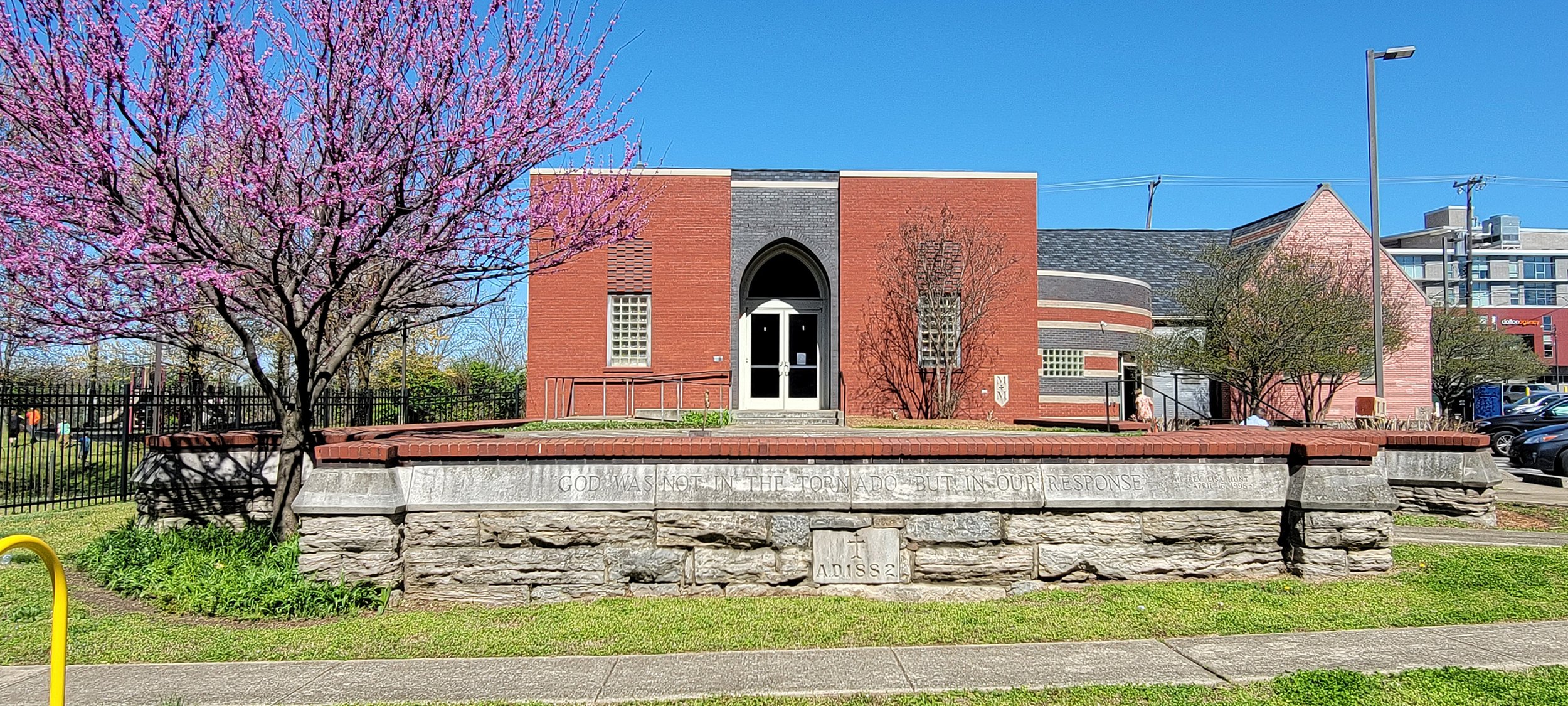
History
God was not in the tornado but in our response.
150 years and still on the Corner…
On Thursday July 29, 1858, 14 men and women met in a little schoolhouse on the corner of Fourth and Fatherland Streets to organize a new Episcopal Church, St. Stephen’s. Dr. John Shelby, a pivotal figure in early Nashville and one of the founding members of Christ Church Cathedral, offered a lot at the corner of Fourth and Boscobel for the construction of a “plain wooden chapel as soon as sufficient money was raised.” In the interim, parishioners met in Jamison’s Hall on Main Street. At the congregation’s formation, St. Stephen’s first vestry issued a “Statement of Appeal” in which it declared, “A new and independent parochial organization has thus been formed, and it is devoutly hoped that it may become a nucleus, around which a future, strong and healthy parish may grow….”
On March 9, 1860, the vestry called The Rev. William D. Harlow as St. Stephen’s first rector and appointed a building committee. In September, the congregation began worshiping in its new home—a wooden structure in the Gothic style, which seated about 100 people. Although traditionally church members rented their pews, St. Stephen’s was a free pew church—the third of its kind in Nashville. However, the vestry did allow those in regular attendance to “appropriate a pew and have it cushioned, etc. providing that all fabric and trims were red in color.”
During the morning service on February 16, 1862, word arrived that Fort Donaldson had fallen and Nashville’s occupation by Federal troops was imminent. No more services occurred in the building until after the Civil War, although the vestry continued to meet and worshipers gathered elsewhere when possible.
By the war’s end, the church was bankrupt. In response, Bishop Quintard, second Bishop of Tennessee, pledged $500 on the condition that the vestry would raise a matching amount. Several members of the Shelby extended family, including Mr. John D and Priscilla (Shelby) Phelan, gave the church property in Edgefield to sell with the request that St. Stephen’s change its name to St. Anne’s in honor of Shelby’s wife, Anna Maria Minnick. Curiously, the “e” was dropped unintentionally in 1871.
By the mid-1870s, financial problems, a population shift away from Edgefield, and an inadequate facility plagued the church. At a vestry meeting in December 1874, Bishop Quintard urged St. Ann’s to build a larger church on another site and to be aggressive in “shaking off this fossilism.”
In February 1879, the vestry called The Rev. T. F. Martin as rector for the annual salary of $1,000. Under his leadership, the vestry purchased a 90-foot-wide lot on Woodland Street—a new home in the old neighborhood.In 1881, William Appleton Potter of New York submitted plans for a new Gothic style, brick church. The cornerstone was laid on June 10, 1882, and the first service held on Christmas Day. The cost of the building was $8,270. In 1886, being debt free, the church purchased the lot between the new building and Fifth Street for a rectory. In July 1892, St. Ann’s established its first mission, St. Stephen’s, at the corner of Josephine and McFerrin in northeast Nashville.
On April 14, 1901, the 22nd anniversary of Martin’s ministry at St. Ann’s was also his final day as rector. During his tenure—the longest of any of the parish’s rectors—St. Ann’s experienced tremendous growth: the church that numbered 82 members on his arrival now boasted 300 communicants. The need for a parish hall and more Sunday school rooms was acute. In September 1902, a new parish hall was completed and named in Martin’s honor. The opening of Martin Hall required a new sexton. On October 14, 1902, Julius Campbell began a two-week trial as sexton. He stayed until 1964.
With the new century, change came to East Nashville. As West End and Belle Meade developed, west Nashville became a more desirable place to live. On March 22, 1916, the worst fire in Nashville’s history raged across Edgefield and hastened the neighborhood’s decline. By nightfall, 64 acres had burned, including 648 dwellings, schools, and churches. Fortunately, St. Ann’s faithful sexton saved the sanctuary and adjacent rectory by keeping the roofs wet with a garden hose from his house and beating out sparks.
Throughout the World Wars and the Great Depression, St. Ann’s and its neighborhood continued to struggle. Twenty-three St. Ann’s communicants served in the Armed Forces in World War I and 39 in World War II. Then, on March 14, 1934, a tornado hit East Nashville and destroyed St. Ann’s bell tower and many other local buildings.At the end of World War II, pressure to leave the Woodland site increased. After a succession of three rectors in seven years, the rectory relocated to Inglewood in 1946.
In the wake of this turnover, The Rev. Elnathan Tartt, Jr. provided stability as rector from 1945 to 1957. The church responded to the pressure to relocate by constructing Howe Hall in 1953. This building served as a chapel and the rector’s office. In March 1958, the vestry voted to establish a new mission in Inglewood—St. James the Less.
St. Ann’s increasingly became an urban parish to which people commuted. In the 1960s, federal urban renewal projects replaced hundreds of single-family homes with Section Eight housing. A commercial and industrial zone developed south of Third Street. The interstate’s path destroyed everything from Third to Fourth Streets, and Ellington Parkway intruded to the church’s back door.
Easter Sunday (circa 1947)
In 1965, St. Ann’s called The Rev. Carson Fraser as rector. He helped parishioners seek diversity and reach beyond the church’s walls into the neighborhood community. Fighting racism and poverty became hallmarks of St. Ann’s ministry. Members started a daycare to serve an increasing number of working mothers. In 1973, another fire, this time started in Howe Hall by an intruder, almost closed the St. Ann’s doors. However, the church remained faithful to an Episcopal presence in East Nashville. In 1975, a historic preservation movement took root. Area residents developed an interest in protecting East Nashville’s history and architecture and moved back into urban neighborhoods.
From 1983 to 1988, under the leadership of The Rev. Michael Moulden, St. Ann’s became a church committed not only to service but also to learning new ways to address the challenges inherent in reconsidering one’s spiritual journey. In response to that commitment, The Rev. Donna Scott joined St. Ann’s as priest associate for pastoral counseling—a bold step for a church still unsure of women’s roles.
St. Ann’s called The Rev. Lisa Hunt as rector in 1989. She was one of the first women in Tennessee to serve in that capacity. When she arrived, she found a church still plagued by financial problems. She balanced the books and challenged her flock to claim its ministry for East Nashville’s diverse community. St. Ann’s became a spiritual home for a wide variety of God’s children, including many gay and lesbian members. Although the current parishioners did not all look like the traditional families of the 1950s, they too had found a welcoming place on the corner of Woodland and Fifth.
On the afternoon of April 16, 1998 a series of tornadoes ripped through Nashville and destroyed St. Ann’s historic 1882 nave and chancel. As Easter lilies swayed behind the surviving altar, members, friends, and many unidentified volunteers began the clean-up and celebrated Eucharist amid the ruins. The next Sunday, Hunt baptized new members in the historic font that had been pulled from the rubble. Holy Name Catholic Church, a neighbor on Woodland, offered sanctuary while St. Ann’s pondered its future. After months of meetings and planning, St. Ann’s launched a capital campaign to renovate the surviving structures and prepared plans for a future nave. The old Martin Hall and Howe Hall became worship and classroom space, respectively. After two years of planning and renovation, the first service occurred in the new space on Christmas Eve, 2000.
Just as St. Ann’s rebounded, so did the neighborhood. Homeowners and businesses replaced blue tarps with new roofs, additions, and renewed spirit. More Nashvillians moved to the east bank. In 2002, a renovated St. Ann’s served as a meeting place for Freedom School, a summer program under the auspices of the Children’s Defense Fund. Serving mainly at-risk youth from the neighborhood, Freedom School evolved into the vibrant East Nashville Hope Exchange, a summer literacy program and hallmark of St. Ann’s ministry. The same year, St. Ann’s took another bold step by purchasing property west of the church to Fourth Street with an eye to future growth.
In 2008, St. Ann’s called Rick Britton, an African American, as its new Rector. He was the first African American rector of a historically white Episcopal Church in Tennessee. In order to continue to grow East Nashville Hope Exchange became a separate non-profit organization in 2011. In 2016, St. Ann’s opened its doors to the newly founded Episcopal School of Nashville, whose kindergarten and elementary school students continue to share the parish grounds and worship space.
After nearly ten years of service, Fr. Rick retired in 2017. The parish called Rev. Kira Austin-Young as interim rector who continues to serve in this role.
For over 150 years, St. Ann’s has been committed to staying on its corner and celebrating the transforming power of the Spirit embracing the risks of ministry, seeking to serve Christ in all persons and working for a just and inclusive world.


